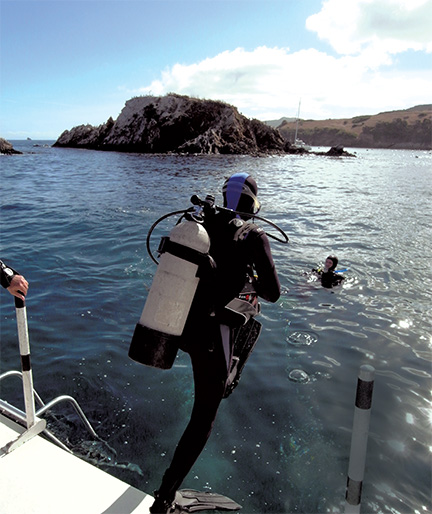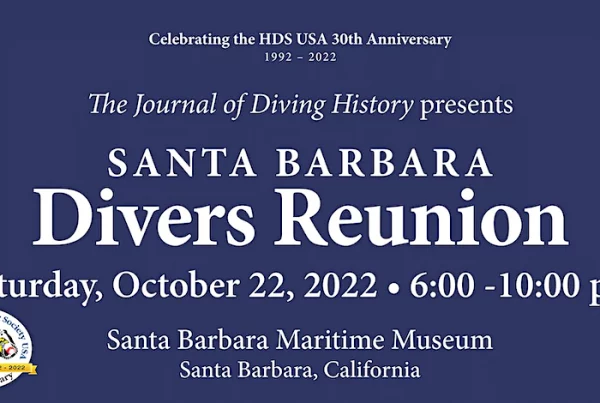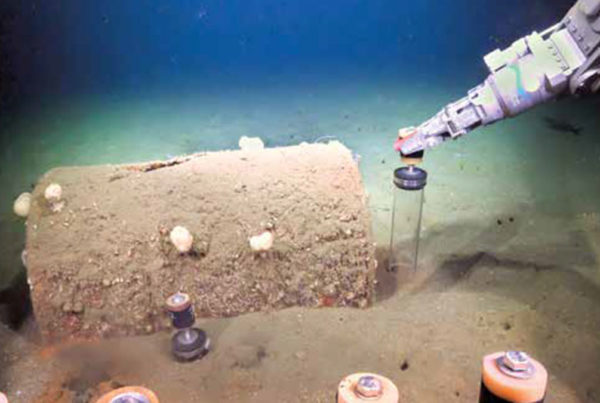 My buddy and I became separated. We could not see each other. Although the water clarity was upward of 50 feet, and we were about 20 feet off the bottom, and only 20 feet apart we were blinded simply by the engulfing mass of silver life that surrounded us. I even had trouble telling which way was up! The school of jack mackerel was massive, the largest I’d ever seen. It must have numbered 10 to 20 thousand, but who was counting or even could. How do we get out of this wall of silver — or did we really want to? I just wanted to let it pulse and glide past me like shimmering mercury on a mirror. It was mesmerizing.
My buddy and I became separated. We could not see each other. Although the water clarity was upward of 50 feet, and we were about 20 feet off the bottom, and only 20 feet apart we were blinded simply by the engulfing mass of silver life that surrounded us. I even had trouble telling which way was up! The school of jack mackerel was massive, the largest I’d ever seen. It must have numbered 10 to 20 thousand, but who was counting or even could. How do we get out of this wall of silver — or did we really want to? I just wanted to let it pulse and glide past me like shimmering mercury on a mirror. It was mesmerizing.
As incredible as this sounds, it’s a common “problem” here. Every time I have dived Indian Rock and its nearby reefs, I have been surrounded by large schools of fish — jack mackerel, blacksmith, anchovies or whatever. This is a remarkable place that is not only exciting but also easy to dive.
Indian rock stands in the middle of Emerald Bay toward the western end of Catalina Island. Emerald Bay is protected in nearly all conditions and is a popular mooring area for pleasure boats. Extensive reefs stretch away from Indian Rock to the east and west. You’ll see rocks just peeking above the surface. Kelp that surrounds these rocks marks the reefs to the west. If diving from a private vessel, use extreme caution approaching this reef.
The western reefs are an excellent area for the beginner diver. For a relaxing, easy dive, try dropping down on the sand area between the main rock and the reefs to the west. The bottom is 30 to 40 feet deep and it is a good place to get orientated and comfortable. It also seems to be a corridor for fish travel. As well as the large schools of small fish, look for halibut and bat rays in the sand. The western reef is extensive and relatively shallow and an excellent place for snorkeling. The seaward edge of the rocks ends at about 60 feet, but there is plenty to explore much shallower.
My personal favorite area of this site is the north side of the main rock. The reef drops away in stair-step fashion bottoming out to sand at 60 to 65 feet on the seaward side. The kelp growth is coming back, working magic as sunlight filters through the fronds. Garibaldi and gorgonian sea fans add splashes of color.
This spot is ideal for photographers. Look in the crevice for octopus, small lobster, and morays with their companion cleaner shrimps. Dozens of small blue-banded gobies dot nearly every square foot of the reef. They make for great photos but with a catch: as many as there are, they are very hard to approach. Patience is the key. Another trick is to find one in or near the spines of an urchin. They feel safer in such a posture and are easier to approach.
This is not a stellar nudibranch location, but you will definitely see the Spanish shawl. Others are present but you’ll have to spend some time looking.
It is nice to see abalone coming back to Catalina and the reefs of Indian Rock are a good place to find them. Like lobsters, they are invertebrates and as such are protected in this section of the island.
The east reefs are less frequently visited. Kelp may or may not be present but the reefs are still extensive and range in depths from 40 to 70 feet. The water is not as clear here but the marine life is just as good.
If you are looking for an easy place to dive Catalina this summer, Indian Rock in Emerald Bay is made to order. If you have a seaworthy private boat this location is good for the educated skipper. Several dive charter boats also visit this spot regularly.
At-A-Glance
Skill Level: All
Location: Front side of Catalina Island toward the end between Eagle Reef and Arrow Point. GPS N33.467997°, W118.526799°
Access: Boat only but the area is reachable by kayaking from the Boy Scout camp on shore.
Entry and Exit: Smooth and easy from your boat or a charter.
Depth Range: 15 to 70 feet. Good snorkeling in shallows.
Conditions: Emerald Bay is protected from prevailing weather so around the rock it is nearly always calm.
Visibility: Good, 30 to 40 feet but often much higher.
Photography: Good for both macro and wide angle.
Hunting: Only finfish may be taken. This is an invertebrate preserve. No lobster, scallops or abalone may be taken.
Cautions: Heavy boat traffic.











